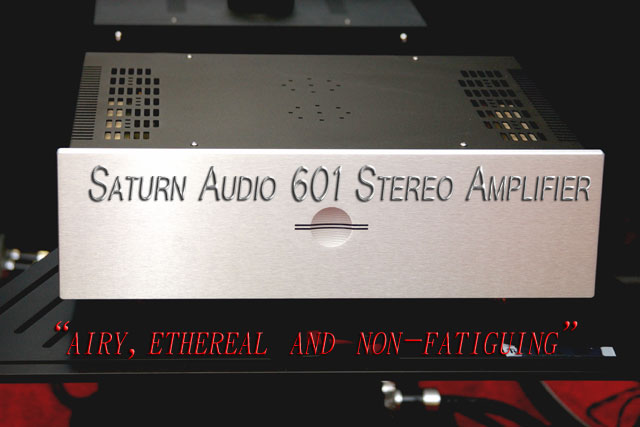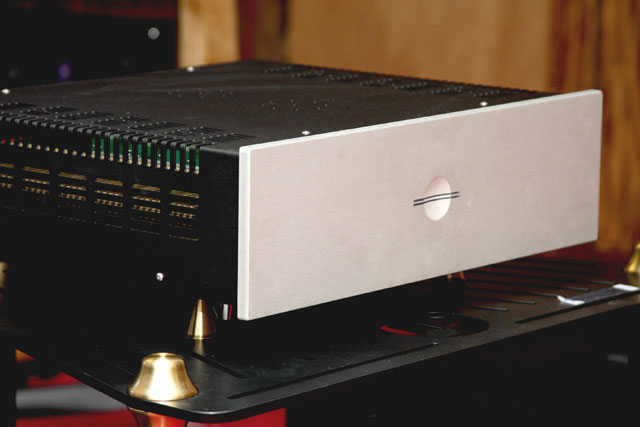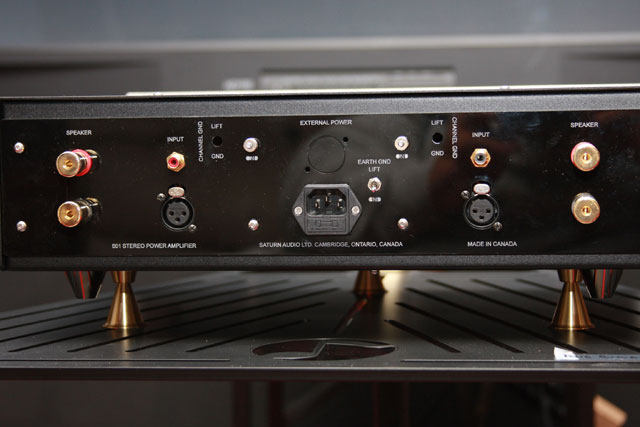Saturn Audio 601 Stereo Amplifier

 I became very interested in Saturn Audio once I found out that Gilbert Yeung, he of Blue Circle Audio fame, would be designing and building electronics for them. When Yeung asked me if I would be interested in reviewing one of their amplifiers, I jumped at the chance. I was curious to see how Yeung would be able to pull this off. I wanted to find out how he would adapt to working for someone else, after owning and running Blue Circle for so long. I was curious about what kind of ideas for equipment design could he come up with. Would he be working under budget constraints? Will he tryout new technologies such as switching amps? Would he have any input on the aesthetics of the equipment? I was not able to get a lot of information from Yeung in terms of what he was designing.
I became very interested in Saturn Audio once I found out that Gilbert Yeung, he of Blue Circle Audio fame, would be designing and building electronics for them. When Yeung asked me if I would be interested in reviewing one of their amplifiers, I jumped at the chance. I was curious to see how Yeung would be able to pull this off. I wanted to find out how he would adapt to working for someone else, after owning and running Blue Circle for so long. I was curious about what kind of ideas for equipment design could he come up with. Would he be working under budget constraints? Will he tryout new technologies such as switching amps? Would he have any input on the aesthetics of the equipment? I was not able to get a lot of information from Yeung in terms of what he was designing.
Yeung wasn’t giving anything away, saying for those types of questions, he’d refer me to Rene Evans, President of Saturn Audio. So, I reached out to Rene Evans, a very knowledgeable gentleman who is passionate about music. We spoke for about an hour about music, electronics, and of all things, Star Trek. By the end of the conversation, we had gone over the review process and hammered out the details for doing a review of the Saturn Audio’s first piece of equipment, the Saturn 601 amplifier.


Technically speaking
The Saturn Audio 601 (henceforth 601) is a very well built 90 watt/channel solid-state amplifier that weighs a hefty 34 lbs., though it feels heavier than that. The 601 I was sent, came in a modereately sized black aluminum chassis and silver faceplate. Black faceplates will be available in September. Evans told me that the 601’s circuit is based on the Blue Circle NSI output stage and utilizes single point grounding. According to Evans, the 601 is, “True balanced from input to output. Both positive and negative binding post are hot. Power supply capacitance at 600,000uF. The 501 and 601 preamp and power amp have the option to be connected together via DCRN system cable similar to the Blue Circle Audio NSC and NSL. Electrically, it will make the preamp and power amp work like an integrated amp. This is an integral part for the Blue Circle NSC and NSL designs.” At the end of this review, you’ll find comments from Evans concerning Saturn Audio and their philosophy which will, hopefully, go a long way towards answering some questions you may have regarding their company.
How It Sounds
 After several days of the 601 being in my system, being fed by my Asus laptop and Tidal (the music streaming service), I felt it was time to see what the collaboration between Saturn and Gilbert Yeung had come up with, and thus began to do some serious listening. My initial impression of the 601 was very interesting. Though there may be some of Yeung’s design’s sonic flavor to the 601, this was a totally different and new creation. I found the sound of the 601 to be very musical and smooth but with a good amount of detail and resolution. The 601’s top end is airy, ethereal and non-fatiguing, with just enough sweetness to allow musical performances to take on that “sounds like it’s in the room” quality. The high frequencies sound accurate. The 601 did an honest job of reproducing the energy that comes along with live shows. The 601’s ambience retrieval sounded true, and its harmonic structure sounded good, though not quite as captivating as some of the better tube amplifiers which are much more expensive as well. The 601 renders a sonic picture with a nice sized palette of tonal colors, but maybe with a slight nod to the warmer side. I found the 601 to do a good job of portraying micro and macro dynamics, and transient response sounded very believable and real. Things don’t fall apart when the performers decide to kick things up a notch or two. I also found the 601’s dynamic shading to be very good. Subtle nuances such as the reverberation and dissipation of well recorded drums was something to be appreciated. Bass reproduction was average, at best, but never gave me cause to wish I had more, especially when the music was playing. The 601 held up much better than what I thought it would when it came to its bass performance. I did enjoy listening to my favorites, particularly smooth jazz and electronic music as well through the 601. The 601 also did a fine job of replicating male and female vocals, allowing the feelings and emotions vocalist sang with to be felt and experienced. Here are some of the musical references used for this review:
After several days of the 601 being in my system, being fed by my Asus laptop and Tidal (the music streaming service), I felt it was time to see what the collaboration between Saturn and Gilbert Yeung had come up with, and thus began to do some serious listening. My initial impression of the 601 was very interesting. Though there may be some of Yeung’s design’s sonic flavor to the 601, this was a totally different and new creation. I found the sound of the 601 to be very musical and smooth but with a good amount of detail and resolution. The 601’s top end is airy, ethereal and non-fatiguing, with just enough sweetness to allow musical performances to take on that “sounds like it’s in the room” quality. The high frequencies sound accurate. The 601 did an honest job of reproducing the energy that comes along with live shows. The 601’s ambience retrieval sounded true, and its harmonic structure sounded good, though not quite as captivating as some of the better tube amplifiers which are much more expensive as well. The 601 renders a sonic picture with a nice sized palette of tonal colors, but maybe with a slight nod to the warmer side. I found the 601 to do a good job of portraying micro and macro dynamics, and transient response sounded very believable and real. Things don’t fall apart when the performers decide to kick things up a notch or two. I also found the 601’s dynamic shading to be very good. Subtle nuances such as the reverberation and dissipation of well recorded drums was something to be appreciated. Bass reproduction was average, at best, but never gave me cause to wish I had more, especially when the music was playing. The 601 held up much better than what I thought it would when it came to its bass performance. I did enjoy listening to my favorites, particularly smooth jazz and electronic music as well through the 601. The 601 also did a fine job of replicating male and female vocals, allowing the feelings and emotions vocalist sang with to be felt and experienced. Here are some of the musical references used for this review:
 A fellow reviewer friend of mine told me about the Kenny Werner Trio’s Live at Visiones: Standards [CD, Concord 4675]. It’s a go to for assessing how equipment processes live recordings. I like to key in on how well engineer, Paul Wickliffe, mic’d the sound of this New York City jazz club and picked up the ambiance, energy and liveliness of the room. Naturally, this CD wouldn’t be worth listening to if the music and the performances were less than impressive, and in this case they most definitely are. The 601 did an exceptional job of putting the trio in my room sounding smooth and realistic. The 601 was essential in helping the system convey the interplay of pianist Werner, bassist Ratzo Harris, and drummer Tom Rainey. Harris owns Miles Davis and Bill Evans’s “Blue in Green”, his bass rendered through the speakers with full expression, and with an incredible amount of bass detail.
A fellow reviewer friend of mine told me about the Kenny Werner Trio’s Live at Visiones: Standards [CD, Concord 4675]. It’s a go to for assessing how equipment processes live recordings. I like to key in on how well engineer, Paul Wickliffe, mic’d the sound of this New York City jazz club and picked up the ambiance, energy and liveliness of the room. Naturally, this CD wouldn’t be worth listening to if the music and the performances were less than impressive, and in this case they most definitely are. The 601 did an exceptional job of putting the trio in my room sounding smooth and realistic. The 601 was essential in helping the system convey the interplay of pianist Werner, bassist Ratzo Harris, and drummer Tom Rainey. Harris owns Miles Davis and Bill Evans’s “Blue in Green”, his bass rendered through the speakers with full expression, and with an incredible amount of bass detail.
 In keeping with the trio theme, Marcus Printup’s A Time for Love [CD, SteepleChase SCCD 31711], features Printup on trumpet; his wife, Riza Hequibal, on concert harp; and bassist Kengo Nakamura. The harp is not that popular in most jazz recordings but here, Hequibal’s playing on Kenny Dorham’s “Blue Bossa” was fast and dynamic in a way I scarcely recall having heard from the harp, especially with a trumpet playing the lead. Driven by the 601 my Tektons clearly allowed me to hear the harp’s speed, articulation, and transient detail, and a rich palette of tonal colors. The trio does a wonderful job with such tracks as “Besame Mucho” and Horace Silver’s “Song for My Father.” I especially like the tone of Printup’s trumpet, and his flugelhorn playing on this disc. Turning to classical, another recording I enjoyed listening to my Tektons being driven by the 601 was Igor Stravinsky’s The Firebird, performed by Antal Dorati and the London Symphony Orchestra [CD, Mercury Living Presence 432 012-2].
In keeping with the trio theme, Marcus Printup’s A Time for Love [CD, SteepleChase SCCD 31711], features Printup on trumpet; his wife, Riza Hequibal, on concert harp; and bassist Kengo Nakamura. The harp is not that popular in most jazz recordings but here, Hequibal’s playing on Kenny Dorham’s “Blue Bossa” was fast and dynamic in a way I scarcely recall having heard from the harp, especially with a trumpet playing the lead. Driven by the 601 my Tektons clearly allowed me to hear the harp’s speed, articulation, and transient detail, and a rich palette of tonal colors. The trio does a wonderful job with such tracks as “Besame Mucho” and Horace Silver’s “Song for My Father.” I especially like the tone of Printup’s trumpet, and his flugelhorn playing on this disc. Turning to classical, another recording I enjoyed listening to my Tektons being driven by the 601 was Igor Stravinsky’s The Firebird, performed by Antal Dorati and the London Symphony Orchestra [CD, Mercury Living Presence 432 012-2].
The 601 allowed the Tektons to show off their imaging capabilities, doing a more than credible job of replicating a full orchestra, and displaying a wide, deep soundstage with a good amount of front-to-back layering. The orchestral timbres were easy to hear, and the system captured the verve and sizzle of Dorati’s interpretation of this ballet’s powerful and continuous finale. The 601 allowed my Double Impacts to keep pace with the explosions of thunder and fire represented by the large timpani. This was the only time during my listening that the bass seemed a little on the loose or boomy side, but still sounded enjoyable none the less. One of my favorite female vocalists is Jane Monheit, and one of my favorite albums that she performs on is Mark O’Connor and the Full Swing Trio’s In Full Swing [CD, Odyssey SK 87880]. One of my favorite tracks on this disc is “Honeysuckle Rose,” with contributions from fiddler O’Connor and guest trumpeter Wynton Marsalis. I have always been taken by Ms. Monheit’s purity of tone and timbre, and her numbers always seem to be nicely arranged. The 601 did an excellent job of allowing the selections feel as if she were present in the room; they captured her breathy singing, and replicated the dimensions and space of the recording venue.
A Few More Thoughts
 The 601 was enjoyable to use. Once you get used to the On/Off switch being under the amplifier, which I took to be a hint that they preferred it be left on most of the time, though it just as well could have been a design innovation that someone came up with. There were no surprising hums, pops, or thumps at turn it on or off. It had no problems at all driving my Tekton Design Double Impacts. I also listened to the 601 on a pair of Meadowlark Heron I’s which it drove wonderfully. I used several interconnect and speaker cable combinations with the 601 and it performed well with all of them. I particularly enjoyed listening to the Dynamic Design Titania and Lotus combination as well my Klee speaker cable and interconnect combo. The 601 did not prefer working with solid state or tube preamps as it performed equally as well with both. In terms of doing any kind of 601 and BCA comparisons; I did not have a BCA amplifier on hand for a direct comparison. I do have some thoughts on the matter at hand. Anyone who Knows Gilbert Yeung and his amplifier designs knows that he is a designer that gives a good amount of thought to power supply performance. Old ship captains would always tell the engine room to give them more steam. Gilbert Yeung’s cry would be to give him more power supply.
The 601 was enjoyable to use. Once you get used to the On/Off switch being under the amplifier, which I took to be a hint that they preferred it be left on most of the time, though it just as well could have been a design innovation that someone came up with. There were no surprising hums, pops, or thumps at turn it on or off. It had no problems at all driving my Tekton Design Double Impacts. I also listened to the 601 on a pair of Meadowlark Heron I’s which it drove wonderfully. I used several interconnect and speaker cable combinations with the 601 and it performed well with all of them. I particularly enjoyed listening to the Dynamic Design Titania and Lotus combination as well my Klee speaker cable and interconnect combo. The 601 did not prefer working with solid state or tube preamps as it performed equally as well with both. In terms of doing any kind of 601 and BCA comparisons; I did not have a BCA amplifier on hand for a direct comparison. I do have some thoughts on the matter at hand. Anyone who Knows Gilbert Yeung and his amplifier designs knows that he is a designer that gives a good amount of thought to power supply performance. Old ship captains would always tell the engine room to give them more steam. Gilbert Yeung’s cry would be to give him more power supply.
The 601 does not have the internal space to put one of Gilbert Yeung’s typical power supplies into. However, Rene Evans mentioned to me that all Saturn amplifiers will be set-up to be able to add additional power supply capacitance which should go a long way towards reaching BCA amplifiers when it comes to bass and slam. The 601 is not quite there yet in comparison to BCA amplifiers in terms of bass extension and drive, but it’s not far off. The bass performance of the 601 is satisfying. One very real comparison I gave a lot of thought to concerning the 601’s performance when I got deeper into listening to it was, a late 1980’s early 1990’s favorite; the Acoustic Electronics Air 2.2 amplifier. During a period in audio, when large amplifiers from Krell, Mark Levinson and Rowland Research were beginning to dominate the audio amplifier landscape, this gem, at more than half their size, competed very favorably with them. The Air 2.2 did not have the same of low-end slam and authority as the larger amplifiers, but it was good enough. Where the Air 2.2 excelled over these larger amplifiers was in its ability to portray music as being livelier and more engaging. The 601 brings back memories of that type of musical performance when I listen to it, only more refined and more capable to being able to handle the intricacies of today’s playback demands. Rene Evans and Saturn Audio have a definite plan for what they’re trying to achieve in their initial assault on the high-end. Their Saturn Audio 601 amplifier is a wonderful start. I am intrigued to see what’s next to come from them and if they can continue with the high level of performance. With the production of the 601, Saturn Audio has set a high bar, not only for themselves, but for solid state amplifiers at the $3,600 price point. And what’s more, its looks and musicality should appeal to a wide swath of audio lovers looking for performance at this level.
Saturn Audio information:
1. Saturn Audio was founded to bring Blue Circle Audio designs to a wider market. Where waiting times for BC products were averaging between 3 – 12 months, Saturn Audio will have stock available for all models.
2. Saturn Audio is 100% built in Canada using materials and parts from both the USA and Canada. My father taught me years ago to “take care of your village or it will not be there to take care of you”. Though we believe in international trade, we have chosen to support our local economies within Canada and the USA with this venture. This also gives us greater control over supply, lead times and quality.
3. Our design philosophy is to place sonic performance value (feel free to reword that) as the top priority. Manufacturing costs can easily push the price up unreasonably and force compromises in performance if accessories and elaborate control systems or chassis designs are introduced. Certainly, many consumers will see these items as important or necessary however we are building for the audio centric buyer.
4. All Saturn products have oversized power supplies. Based on Gilbert’s “more power equals greater stability and less tension in the output delivery” concept, the best example is to compare a 2-cylinder engine to a 8 cylinder power plant. The larger engine will perform effortlessly in almost every condition.
5. Add on power supply upgrades. All Saturn products will be able to benefit from Plug and Play add on external power supplies. The 801 is ideal for the lower current demanding DAC, phono stage and preamplifiers and the 901 for the amplifiers and integrated amplifiers. The upgrade is simple and does not require any modifications and can easily be installed at home by the consumer through a simple cable connection.
6. Saturn Audio offers a 10-year warranty.
7. All Saturn Audio products are individually inspected and electrically certified for use in Canada and the USA.
8. My background is quality management and manufacturing operations management therefore quality is the core of everything we do at Saturn Audio. In fact, we chose our suppliers based on their focus on quality, expertise, reliability and performance. Cost came second to these criteria though we feel we have managed costs appropriately.
9. Saturn Audio has the latest and most advanced designs available from Gilbert.
10. Due to efficiencies in higher production volume, Saturn products have a superior performance to cost ratio = More quality audio Blue Circle sound for the buck.


mike wright
Saturn Audio 601 Amplifier
Specifications:
Weight – 34 lbs.
Output – 90w / 8Ω and 150w/4Ω
Circuit based on Blue Circle NSI output stage.
Single point grounding.
True balanced from input to output. Both positive and negative binding post are hot.
Power supply capacitance at 600,000uF
BAL and SE input
Frequency response: 15Hz to 30KHz, +0.00db/-0.05db
Price: $3,600 USD
Contact:
René Evans
President
Saturn Audio Ltd.
www.saturnaudio.com
519-242-4503
Stereo Times Masthead
Publisher/Founder
Clement Perry
Editor
Dave Thomas
Senior Editors
Frank Alles, Mike Girardi, Russell Lichter, Terry London, Moreno Mitchell, Paul Szabady, Bill Wells, Mike Wright, and Stephen Yan,
Current Contributors
David Abramson, Tim Barrall, Dave Allison, Ron Cook, Lewis Dardick, John Hoffman, Dan Secula, Don Shaulis, Greg Simmons, Eric Teh, Greg Voth, Richard Willie, Ed Van Winkle, Rob Dockery, Richard Doran, and Daveed Turek
Site Management Clement Perry
Ad Designer: Martin Perry





Be the first to comment on: Saturn Audio 601 Stereo Amplifier